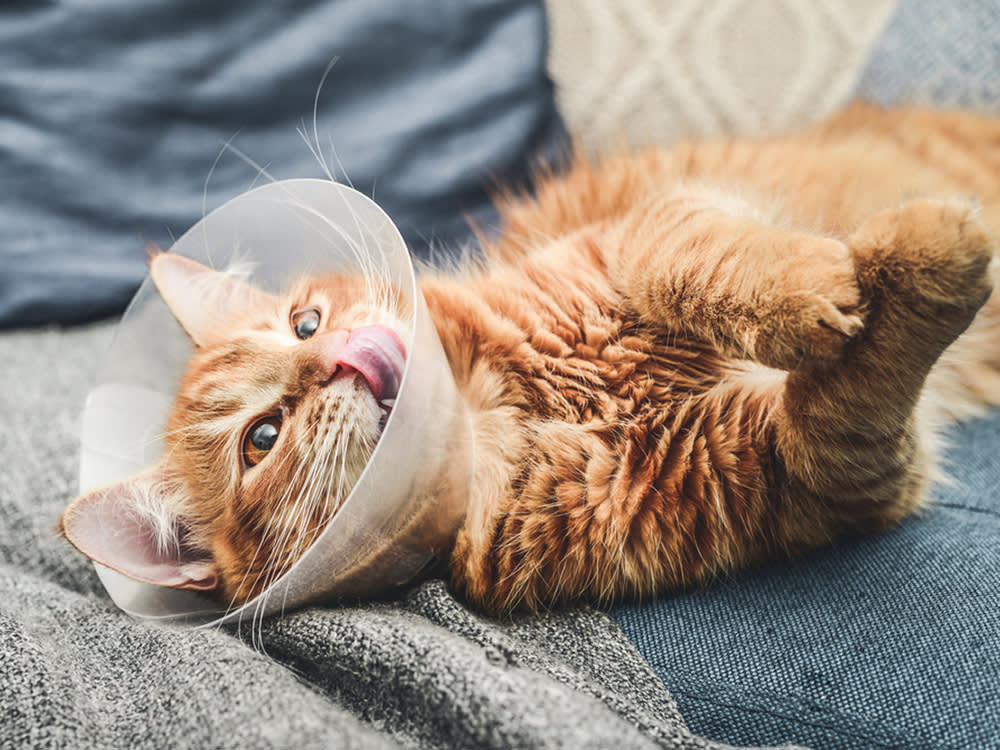Neutering Male Cats: Behaviour and Recovery Guide
If you’re bracing yourself for some wackiness, don’t worry – it won’t last forever

Share Article
Part of being a good cat parent is doing things for your kitty that suck for them now but benefit them in the long term. Cats aren’t super-great at listening to reasoned explanations about why you take them to the vet, don’t share your food with them, or keep the door to the garage closed.
It can be scary for both of you, but neutering your male cat or kitten trades a few days of discomfort for life-long rewards. Even though this is a routine procedure, there may be some unexpected changes after surgery, especially if you haven’t been through it with a cat before.

littleKin™ is Kinship’s home just for puppy and kitten parents. Bop over to check out expert advice, new pet tools, and special deals—all curated for your newest family member.
opens in a new tabWhat is cat neutering?
Neutering is a sterilisation procedure that removes a male cat’s testicles. It’s a very simple concept: no balls, no babies. In most cats, this is a very quick procedure that is done under anesthesia with two small incisions into the scrotum. These small incisions usually do not require sutures, which is great because cats hate those things.
In some cats, one or both of the testicles do not descend into the scrotum like they should. This is called cryptorchidism. In cryptorchid cats, a more involved surgery is needed to get to the testicles. This can often involve an incision into the abdomen to find and remove them.
What are the benefits of neutering?
The biggest benefits of neuteringopens in a new tab that you’ll see are behavioural, but there are other advantages to the procedure as well. Sterilisation prevents your cat from breeding. There are already plenty of great cats and kittens in rescue centres waiting to be adoptedopens in a new tab, and you don’t need your male cat out there making more. There are also health benefits related to a decreased risk of testicular cancer (obviously) and an overall longer lifespan in neutered cats.
What behavioural changes are expected after a male cat is neutered?
Reduced aggression
Testosterone drives a lot of the more annoying behaviours of male cats. Removing the testicles removes the biggest source of testosterone from the body. In free-roaming cats, aggressive behavioursopens in a new tab like fighting and vocalisation were reduced after neutering. This helps with indoor cats, too. It’s no fun waking up to a blood-curdling yowl from your cat because something dared step into the garden he’s guarding through the window.
Reduced roaming
Without the effects of testosterone, cats are much less likely to try to travel far and get in trouble. After neutering, cats’ general activity level decreasesopens in a new tab, and they’re much happier to sit around and enjoy the day.
Reduced spraying
Intact male cats want to lift their tail and mark everything with urine to claim it as their own. And their pee stinks. It stinks in a way that lingers in your nose and sticks to your clothes. No one wants their house to smell like that, and neutering fixes that problem quickly.
Improved litter box habits
Less pee on your walls and furniture means more pee in the litter box. Neutered cats are much more content to follow your desire to not have them urinate on everything you own. Fewer surprise wet spots lead to a much happier relationship overall.
Increased affection
Neutered cats are more affectionateopens in a new tab with their families and less feisty with any other cats they live with. Intact cats can still be plenty friendly, but why choose less kitty love when you can have more?
How soon will I notice changes in my male cat’s behaviour after neutering?
Testosterone takes a month or two to leave the system, so some behaviours and odours can persist through that time. Despite this, some results of hormone changes, such as increased appetite, can be seen as soon as three days after surgery. Generally, you can expect younger cats to calm down (well, calm for a kitten) more quickly, while older cats may have some habits that take longer to go away.
How to recover a male cat after neutering?
The best bet is always to follow the advice of the veterinarian who did the procedure. They will know what type of procedure was done, if there were any complications, and what medications your kitty has been given. Although every cat and every procedure are different, some general advice can be followed.
How to care for your cat after surgery
Cats should take it easy after surgery. This is often easier said than done, especially when kittens are involved. Your vet may recommend confinement to a large crate or a small room without furniture to jump on. The big thing is to prevent them from traumatising their surgery site and causing bleeding.
After surgery, cats will often go home with a cone that should be kept on until the incisions are healed. Cats hate wearing cones and are very good at twisting themselves into knots to wiggle them off. Try to keep the cone in place and watch your cat closely to make sure they‘re not getting into trouble and licking their incision. Watch the scrotum or the incision for any signs of discomfort, redness, swelling or discharge and report any issues to your vet.
Common complications of neutering
Fortunately, post-operative complicationsopens in a new tab are rare after neutering. Bleeding from the surgery site or swelling of the scrotum is possible. Infection can occur after any incision but is uncommon, unless the cat licks at the area. Although surgical complications are infrequent, hormonal changes can cause issues if you’re not vigilant.
The most common complication of neutering a cat is weight gain. Because of hormone shifts after being neutered, male cats often begin to try to eat more after being neuteredopens in a new tab. This can lead to rapid weight gain, with adult cats in studies gaining about 20-28 percentopens in a new tab of their body weight within six months after surgery. This is hard on joints and can increase the risk for diabetes and heart disease.
Weight gain can be avoided by getting your cat used to set meal feedings (rather than being free-fed) before surgery and monitoring their weight and body condition every two weeks after surgery. Staying vigilant about your cat’s weight early in life will make keeping them trim and lean in their later years much easier.
Any surgery is a big deal, but neutering is a routine procedure that has many benefits that will improve life for both you and your cat. Discuss the right time to have your male cat neutered with your veterinarian.
Frequently asked questions
Does a male cat’s behaviour change after neutering?
Neutering can lead to many positive behaviour changes for male cats, such as decreased aggression, reduced roaming, decreased urine spraying and increased affection.
What to expect after a male cat is neutered?
Expect your cat to be a little subdued for a few days after being neutered. Increased appetite is common after neutering and weight gain needs to be prevented.
Do male cats become less affectionate after neutering?
If anything, male cats tend to become more affectionate with people after neutering. They also become more tolerant of other cats in their area.
How long does it take for male cats to calm down after neutering?
It can take one to two months for testosterone levels to bottom out after a cat is neutered, so behaviours caused by the hormone can take that long to go away.
How do I keep my male cat calm after neutering?
Confining your cat after neutering is recommended to prevent injury. Your veterinarian may recommend sedative medications if your cat isn’t able to stay calm.
What is the best age to neuter a male kitten?
Neutering is safe for kittens as young as seven weeks of age. Many veterinarians will wait until after vaccines are done at about four months of ageopens in a new tab to neuter.
References

Dr. Bartley Harrison, DVM
Dr. Bartley Harrison, DVM is a small animal veterinarian based in North Carolina who has practiced emergency medicine since graduating from the Texas A&M College of Veterinary Medicine. His primary interest areas include pain management, cardiology, and the treatment of shock.
He is a member of the Veterinary Emergency and Critical Care Society, American Veterinary Medical Association, and American Medical Writers Association. In addition to his clinical work, he writes pet health articles to help provide accurate information for both new and experienced pet parents. When he’s not working, he enjoys cooking, traveling, reading, and going on adventures with his dog.
Related articles
![cat playing fetch]() opens in a new tab
opens in a new tabHow to Train a Kitten to Fetch
Move over, pups. This is a cat’s game, too
![A gray cat in a tan cat carrier]() opens in a new tab
opens in a new tabYour Cat Doesn’t Have to Hate Their Carrier
A behaviourist’s six surefire steps to training a cat to go in a carrier
![Cat sitting in a teal litter box]() opens in a new tab
opens in a new tabMastering the Art of Litter Box Training: How to Train Cats to Use a Litter Box
If you do nothing else, teach your cat to poo in their litter box (and not in your shoe)
![Training a cat sitting with leash and harness on.]() opens in a new tab
opens in a new tabA Step-by-Step Guide On How to Clicker Train Your Cat
This popular training technique isn’t just for dogs. Here’s how you can make it work for your cat





